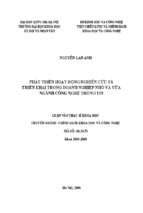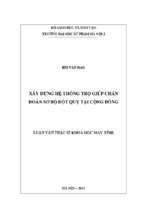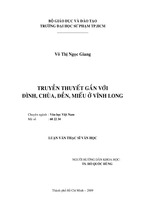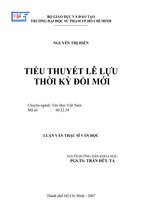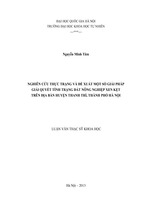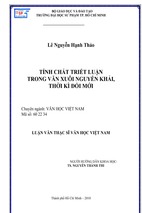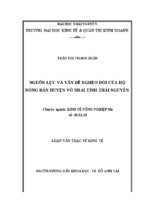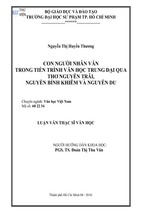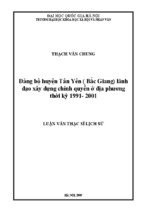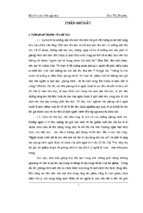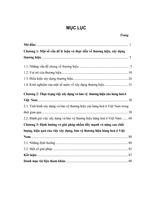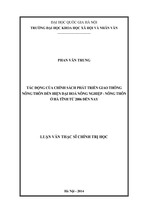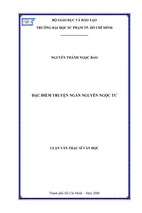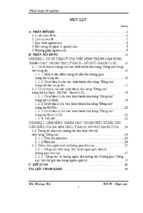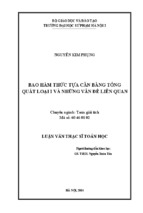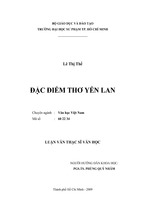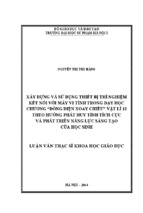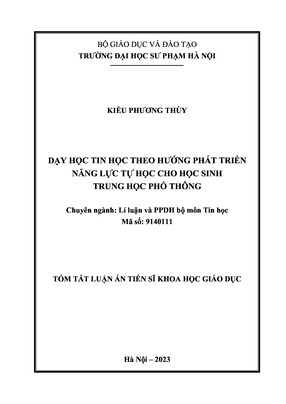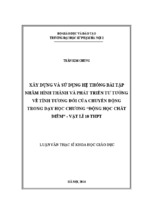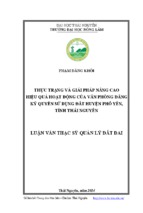nghiên cứu của Janet Cheng Lian Chew (2004)
The Influence of Human Resource Management
Practices on the Retention of Core Employees of
Australian Organisations:
An Empirical Study
Janet Cheng Lian Chew
B.Com. (Hons) (Murdoch University)
Submitted for the degree of Doctor of Philosophy,
Murdoch University
July, 2004
I declare that this thesis is my own account of my research and
contains, as its main content work which has not previously been
submitted for a degree at any tertiary education institution.
..........................
Janet Cheng Lian Chew
July 2004
© Copyright
All rights reserved
ABSTRACT
Employee retention is one of the challenges facing many business
organisations today. For many organisations, strategic staffing has
become a concern because the ability to hold on to highly talented
core employees can be crucial to future survival. This empirical study
examined the current human resource management (HRM) practices
of Australian organisations in the retention of their core employees.
In particular, the research identified the core elements of HRM
practices, which strongly influence the decision for core employees to
stay.
The
study
comprise
three
phases:
(1)
a
preliminary
investigation, utilising the Delphi Technique to obtain the opinions of
an expert panel of thirteen, (2) in-depth interviews, involving twelve
human resource managers of Australian organisations and (3) a
quantitative
survey
of
800
employees
from
nine
Australian
organisations.
The findings revealed greater insights into the HRM-retention
relationship and provided empirical validation of the relationship.
More specifically, the research identified eight retention factors that
influence the decision of core employees to stay. These specific
factors consisted of two bundles of practices: HR factors (e.g., person
organisational fit, remuneration, reward and recognition, training and
career
development,
challenging
job
opportunities)
and
Organisational factors (e.g., leadership behaviour, company culture
and
policies,
teamwork
relationship
and
satisfactory
work
environment). The outcome of the HRM-retention relationship was
examined through organisational commitment and turnover intention
using multiple regression analysis.
The findings of this study revealed positive significant corelationships
between
the
eight
factors
and
organisational
commitment. Moreover, it was highlighted that commitment acted as
a partial mediator of remuneration, recognition and reward, training
and career development and work environment on intent to stay.
Commitment fully mediated the relationship person organisational fit,
teamwork relationship, culture and policies and intention to stay.
The study produced a model suitable for use by human
resource practitioners as a guide in determining what initiatives an
organisation should adopt to retain their critical employees.
This research has also made a contribution by illuminating the
current employment relationships in Australian organisations and
providing relevant empirical evidence to support the theoretical model
of Human Resource Architecture, developed by Lepak and Snell
(1999) and, as a result, creating a configuration for an Australian
Human Resource Architecture model.
CONTENTS
List of Figures
List of Tables
List of Appendices
Acknowledgements
vi
vii
vii
viii
CHAPTER ONE: INTRODUCTION
The Influence of Human Resource Practices on the Retention of Core
Employees
Introduction
Changes in the workforce
The influence of HRM on retention
Retention management – a strategic tool
Purpose of the study
Significance of the study
Research focus
Conclusion
Thesis overview
1
3
6
10
16
17
19
20
20
CHAPTER TWO: LITERATURE REVIEW
To examine the relationship between Human Resource Management
and Retention
Introduction
The Human Resource architecture models
Applying Holistic or Differential HR Practices?
Needs of core employees
Human Resource management practices
Human resource management factors
Human Resource Factors influencing retention
Organisational commitment
Turnover intention
Turnover predictors
Conceptual schema
Conclusion
23
24
30
35
37
43
45
65
73
76
79
80
CHAPTER THREE: RESEARCH METHODOLOGY
A Three-Phased Study: The Delphi method, In-depth Interview and
Quantitative survey
Justification of three-phased approach
Sample population (Phase 1 Delphi Study)
Methodology (Phase 1)
Application of the Delphi Technique
Instrument (Delphi)
Delphi data collection and analysis
Sample population (Phase 2 and Phase 3)
Methodology (Phase 2)
Interview format
Interview data collection and analysis
Phase 3 Employee survey
Phase 3 Data collection and analysis
Conclusion
82
84
87
89
90
92
95
96
97
98
99
100
101
CHAPTER FOUR: THE DELPHI STUDY
Identifying the Human Resource Management Factors that influence
the Retention of Core Employees
Demographics of panel members
What is a core employee?
Do core employees have different needs to other non core employees?
What are the factors affecting an Australian Human Resource architecture
model
Which HR factors most influence the decision of employees to stay?
Human Resource factors
Organisational factors
Discussion and implications
105
106
107
109
112
114
115
117
CHAPTER FIVE: INTERVIEW RESULTS
The Retention Management Practices of Australian Organisations
Introduction
Respondents’ profile
Interview outcome
Descriptions of core employees
HRM factors influencing retention
Interviewees’ comments on HR Practices
Is the importance placed on HRM factors linked to retention?
How are these influential HR factors managed in organisations?
How do these differ from non-core employees?
Discussion and Implications
124
126
127
127
130
133
134
139
142
143
CHAPTER SIX: QUANTITATIVE SURVEY (Phase 3)
Investigating the relationship between HRM factors, organisational
commitment and intention to stay
Introduction
Theoretical background and hypotheses
Instrument
Research Questions
Hypotheses
Sample population
Data collection process
Measurement of construct: independent variables
Independent Variables
Person organisation fit
Remuneration, reward and recognition
Training and career development
Challenging job opportunities
Organisational factors
Leadership behaviour
Teamwork relationship
Organisational culture and policies
Communication and consultation
Satisfactory work environment
Dependent variables
Organisational commitment
Intent to stay (turnover intention)
Data analysis
Missing data
Exploratory factor analysis
Means, and standard deviations and correlations
Multiple regression analysis
Results
Demographic profile
Construct validity of all variables used in the study
Exploratory factor analysis
Measures of reliability
Means, standard deviations and correlations
Multiple regressions
Discussion: Findings of the study
Conclusion
149
150
151
151
156
156
158
158
159
160
160
160
161
161
162
162
163
165
165
166
166
166
167
168
168
170
173
173
176
183
189
CHAPTER SEVEN: DISCUSSION AND IMPLICATIONS
Validating the HRM Retention Mode
Introduction
Review of Findings
Phase One Study
Phase Two Study
Phase Three Study
Contributions
What’s New?
So What?
Why So?
190
190
193
194
198
199
201
202
Well Done?
Done Well?
Why Now?
Who Cares?
Limitations
Future Research
Conclusion
204
205
206
207
208
211
213
Appendix 1
214
Appendix 2
215
Appendix 3
216
Appendix 4
222
Appendix 5
229
Appendix 6
231
Appendix 7
232
Appendix 8
239
Appendix 9
248
List of References
251
LIST OF FIGURES
Figure 1.1: A three-phased study to determine key HR factors that
influence retention of core employees
21
Figure 2.1: Human resource management factors that influence
retention of core employees
81
Figure 3.1: The Delphi Procedure
91
Figure 6.1: Conceptual Schema: Human Resource Management Factors
that Affect Retention of Core Employees of Australian
Organisations
153
Figure 7.1: Final Model: Human Resource Management Factors that
Affect Retention of Core Employees of Australian Organisations
213
LIST OF TABLES
Table 2.1 Employment modes of Human Resource Architecture
27
Table 3.1 Summary of the Delphi Process
94
Table 3.2 Phase measurement scales
102
Table 4.1: Demographic characteristics of the Delphi Panel members
106
Table 4.2: Top five descriptions of a core employee
107
Table 4.3: Needs of core employees
108
Table 4.4: Factors affecting the Australian Human Resource architecture
model
110
Table 4.5: Top five human resource factors influencing retention
113
Table 4.6: Top five organisational factors influencing retention
116
Table 5.1: Demographic characteristics of participating organisations
127
Table 5.2: Interviewees selection of top five HR factors influencing
retention
130
Table 5.3: Phase 2 Interviewees selection of top five organisational factors
influencing retention
132
Table 5.4: Level of importance of Identified Human Resource and
organisational factors in relation to voluntary turnover rate
135
Table 6.1: Demographic data of respondents (Age, Gender, Industry and
Occupation)
169
Table 6.2: Factor analysis of HRM factors.
171
Table 6.3: Means, Standard Deviations and Correlations for all Variables
174
Table 6.4: Regression Results (Un-standardised Coefficients) for
Organisational Commitment as Dependent Variable
178
Table 6.5: Regression Results (Un-standardised Coefficients) for
Organisational Commitment as Dependent Variable
179
Table 6.6: Regression Results (Un-standardised Coefficients) for Turnover
Intention as Dependent Variable
181
Table 6.7: Regression Results (Un-standardised Coefficients) for Turnover
Intention as Dependent Variable
182
ACKNOWLEDGEMENTS
The process I have taken to create and complete this thesis has
provided me with a platform to better understand my capabilities and
skills both personally and academically. This journey of self
actualisation would not have been fulfilled without the guidance and
support of several individuals.
I would like to take this opportunity to thank several people
who have assisted me directly or indirectly in successfully completing
this momentous task.
To my two greatest achievements, my lovely daughters, Sofia
and Anjuli, I am fortunate to have had your love and emotional
support throughout the whole process.
My deep appreciation is extended to my supervisor Lanny
Entrekin for his wisdom and guidance.
To my friend and statistical supervisor, Tonia Girardi, my
sincere thanks for her encouragement and guidance.
I am grateful to Shelda Debowski, for her guidance and
encouragement during the initial process.
To my good friend, Eve, I am deeply thankful for her constant
TLC in times of stress.
Finally, to my Mum, thank you for your love and devotion.
Predictors
Independent Variables
•
•
•
•
Dependent Variables
Age
Gender
Occupation
Industry
Human Resource Factors
•
Person Organisation Fit
(Selection)
•
Remuneration and
Recognition
•
Training and Career
Development.
•
Challenging opportunities
Organisational
Commitment
Affective
Commitment
Turnover
Intention
Intent to Stay
Calculative
Commitment
Organisational Factors
•
Leadership
Behaviour
•
Teamwork
relationship
•
Company Culture
and Policies
•
Work environment
FIGURE 2.1. Conceptual Schema. Human Resource Factors that Affect
Retention of Core Employees of Australian Organisations
81
Predictors
Human Resource Practices
•
Person Organisation Fit
(Selection)
•
Remuneration and Recognition
•
Age
•
Gender
•
Industry
•
Occupation
Training and Career
Development.
•
•
Challenging Opportunities
Organisational
Commitment
Organisational Factors
•
Leadership Behaviour
•
Teamwork relationship
•
Company Culture and Policies
•
Turnover
Intention
Work environment
Intent to Stay
FIGURE 6.1 Conceptual Schema: Human Resource Management Factors
that Affect Retention of Core Employees of Australian Organisations
153
Predictors
•
•
Age
Gender
Human Resource Practices
•
Person Organisation Fit
(Selection)
•
Remuneration and
Recognition
•
Training and Career
Development.
Organisational
Commitment
Intent to Stay
Organisational Factors
•
Teamwork relationship
•
Company Culture and
Policies
•
Work environment
FIGURE 7.1: The Final Model: Human Resource Factors that Affect
Retention of Core Employees of Australian Organisations
214
Variable
Mean
S.D
1
2
3
4
5
6
7
8
9
10
11
12
13
1. Age
N/A
N/A
-
2. Gender
N/A
N/A
0.06
-
3. Occupation
N/A
N/A
0.02
0.04
-
4.Industry
N/A
N/A
0.01
0.02
0.06
-
5. Person/ organisational fit
4.30
1.06
-0.02
0.15**
0.01
0.17**
0.54
6. Remuneration and Recognition
3.98
1.16
0..09**
-0.001
0.01
0.10*
0.46**
0.76
7. Training and Career
4.09
1.48
-0.04
0.11*
0.07
0.15**
0.50**
0.54**
0.82
8. Challenging Assignments
4.75
1.17
0.04
0.98*
0.14*
0.26**
0.48**
0.52**
0.59**
0.85
9. Leadership
3.66
1.43
0.01
0.08**
0.06
0.12**
0.61**
0.6**
0.65**
0.62**
0.94
10.Teamwork
4.57
1.26
-0.06
0.05
0.08
0.04
0.55**
0.50**
0.55
0.54**
0.69**
0.89
11. Company culture and policies
4.34
1.30
0.04
0.08
0.05
0,02
0.51**
0.53**
0.62**
0.56**
0.71**
0.59**
0.85
12. Work environment
4.23
1.37
0.07
0.14*
0.11*
0..02
0.59**
0.52**
0.54**
0.56**
0.68**
0.56**
0.56**
0.69
13. Commitment
4.47
1.13
0.17**
0.18**
0.08
0.07
0.55**
0.57**
0.52**
0.57**
0.62**
0.57**
0.58**
0.66**
0.82
14. Intention to stay
4.41
1.58
0.28**
0.12**
0.06
0.02
0.45**
0.45**
0.42**
0.46**
0.44**
0.43**
0.49**
0.49**
0.66**
Coefficient alpha reliability estimates, are on the diagonal and in bold. The means of all the variables were scored on seven point scales where 1
represents strongly disagree and 7 strongly agree. Age was measured by three categories, Gender was categorised 1 = male, 2= female. **p<0.01,
*p<0.05
Table 6.3. Means, Standard Deviations and Correlations for all variables (n=457)
174
14
0.82
- Xem thêm -

